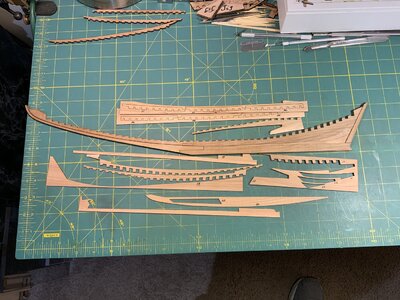- Joined
- Sep 4, 2022
- Messages
- 127
- Points
- 113

Over the few weeks that I have been working and assembling all of the parts that male up the keel and deadwood I have had the sense that the wood was darkening. I consciously wondered it it was actually happening or if I was imagining it, not sure but also not really denying it. I shrugged it off as possibly skin oils from my hands along with the ongoing and ever present charcoal dust from laser cut edges being worked.
So tonight my curiosity got the best of me and I proved it to myself by laying out the keel assembly with some of the leftover wood that surrounded the keel pieces. There, side by side under the same light lies the proof of patina. I actually like it. It reminds me of how black cherry, my favorite cabinet wood, darkens as it ages. I wonder if this might be a feature of pear wood?, or is it merely external from my handling, skin oil and laser charcoal?
In any event, I like it.
alf in Iowa

So tonight my curiosity got the best of me and I proved it to myself by laying out the keel assembly with some of the leftover wood that surrounded the keel pieces. There, side by side under the same light lies the proof of patina. I actually like it. It reminds me of how black cherry, my favorite cabinet wood, darkens as it ages. I wonder if this might be a feature of pear wood?, or is it merely external from my handling, skin oil and laser charcoal?
In any event, I like it.
alf in Iowa

Last edited:



